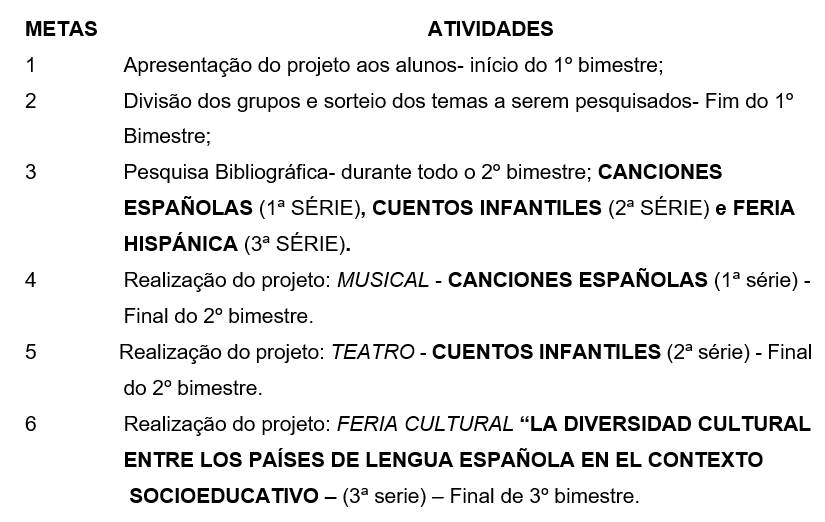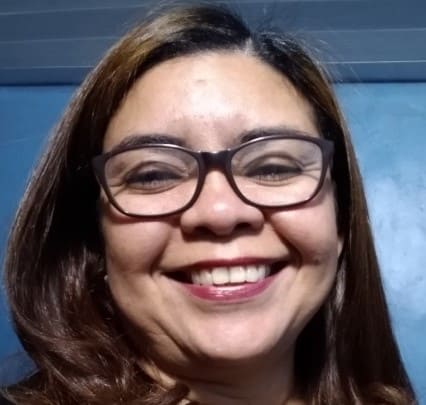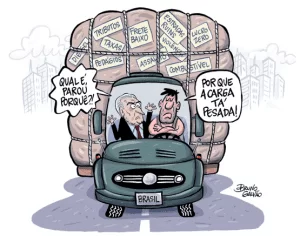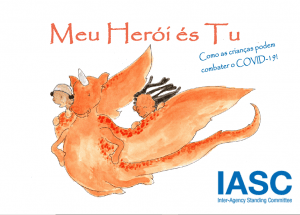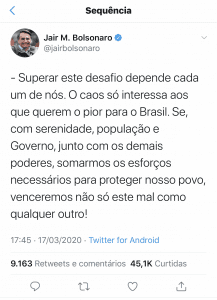ORIGINAL ARTICLE
CORREA, Silvana Serra Costa [1]
CORREA, Silvana Serra Costa. Cultural diversity among Spanish-speaking countries in the socio-educational context. Revista Científica Multidisciplinar Núcleo do Conhecimento. Year 05, Ed. 05, Vol. 12, pp. 138-145. May 2020. ISSN: 2448-0959, Access link: https://www.nucleodoconhecimento.com.br/lyrics/socio-educational-context
SUMMARY
This paper presents the importance of disseminating the teaching of the Spanish language in public schools in Manaus- Amazonas, presenting the importance of knowing the teaching of the Spanish language, inserting the procedures for constructing methods to apply in schools with the objective of valuing learning. The article “Cultural diversity among Spanish-speaking countries in the Socio-educational Context” addresses the interest of students for the development of studies in the theoretical foundations and applicability of the project basing a dialogue in the light of scientific knowledge and authors referenced in this article. Therefore, we tried to problematize through research in books, internet and presentations such as: music, theater and cultural fairs where they demonstrate the results achieved and the knowledge acquired through the mastery of the language.
Keywords: Teaching, culture, knowledge, Spanish, diversity.
1. INTRODUCTION
The Spanish language has been expanding all over the world over the years, it can be observed that there is a need for a good part of society to have knowledge of other languages. Thus, the importance of teaching the Spanish language in the educational sphere brings a fundamental meaning to the social life of the student body and contributes to the integral development of these subjects.
To carry out the present work, the objective was to encourage the search for information through bibliographic and Internet research, valuing knowledge about music, literature and the diversity of Spanish culture.
Therefore, this theme was chosen with the intention of seeking information through theoretical foundations, as well as emphasizing language learning through music, reading and knowledge of the historical context of Spanish culture. The project expresses the interest of students to learn and understand the knowledge of the Spanish language, seeking information for written learning, opinions, ideas and values based on scientific theories and also by experiences experienced by other people.
The school is a means of social life that reflects in the behavior and performance of society, that is, favoring communication, resizing the relations between community and school, thus the relevance of identifying the positive and negative aspects of a participatory school before the development of society, it is important to achieve objectives that reflect on the achievements and innovations of school education.
The research will be qualitative, it will be carried out through the consultation of articles, books and internet according to the theme studied. Clothing making for theatrical presentation of Children’s Tales; Preparation of scenarios for theatrical presentation of Children’s Tales; Preparation of panels for the Hispanic Fair; Making shirts for the presentation of the Hispanic Fair; Microsistem, CDs, Data show, computer, speaker and microphones for music and dance presentation.
2. THE IMPORTANCE OF THE SPANISH LANGUAGE TODAY
The Spanish language is officially used in 21 countries: Spain, Mexico, Guatemala, Costa Rica, Panama, Nicaragua, El Salvador, Honduras, Cuba, Dominican Republic, Colombia, Venezuela, Ecuador, Peru, Bolivia, Chile, Paraguay, Argentina, Uruguay, Equatorial Guinea and Puerto Rico. It is not more than the second most spoken language in the United States.
According to law 11.161 that was enacted by the National Congress and sanctioned in August 2005 by President Lula:
Art. 1° The teaching of the Spanish language, of compulsory offer by the school and optional enrollment for the student, will be gradually implemented in the full curricula of high school. § 1 ° The implementation process must be completed within five years, from the implementation of this Law. § 2 The inclusion of the Spanish language in the curricula full of elementary school from 5th to 8th grades is allowed.
In Manaus, the schools of the state public school system joined the teaching of the Spanish language in the beginning of the school year 2005. With the need to prepare our students for the labor market and follow their social development, and also to seek the expansion of the school itself, its knowledge about music, literature, parties, typical dances and customs of each country that has Spanish as its official language.
During classes there is always a lot of interest on the part of students in knowing about the differences in terms of beliefs, customs and traditions between Brazil and spanish-speaking countries, such as the “Día de los muertos” in Mexico, which is truly celebrated with ornaments, food and much joy, different from the Day of the Dead in Brazil, which is seen as synonymous with sadness and longing. Taking into account differences such as these, we feel the need to develop a research project, where we can encourage them to seek this information and present it through music, theater and a Hispanic Fair.
According to Junger (2005), the points of contact (lexicon and morphosymptotic structures) between Spanish and Portuguese also favor a more immediate approach to the foreign language by our students, allowing from an early age access to texts taken from documents of daily use of Hispanic-speakers, with a certain degree of complexity.
Thus, the Project that will be called: “The Cultural Diversity Among Spanish-Speaking Countries In the Socio-educational Context”, has as main objective to value the teaching of the Spanish language in the cultural context in a practical, broad and dynamic way, since the execution of the same will also serve as a requirement for partial note. This work will appear at the beginning of bibliographic and Internet research on music, dances, literature and different customs among Hispanic countries. Then, we will work on the making of clothing for the theatrical presentation of children’s tales and in the exhibition of the Hispanic Fair. To promote learning through the collection of information from the students themselves is to enrich them from the noblest of life’s values: knowledge. This work will be directed to high school students, distributed as follows: 1st year (Canciones Españolas); 2nd year (Literature: Teatro- Cuentos Infantiles) and 3rd year (Feria Hispánica).
In this sense, for Morin (2007), understanding is, at the same time, the means and end of human communication. The planet needs, in every way, mutual understanding. Considering the importance of education for understanding, at all educational levels and at all ages, the development of understanding calls for the reform of mentalities. Following this understanding, we approach the relevance of this project so that everyone in the educational field can appropriate the knowledge of the cultural diversities of learning the Spanish language.
2.1 RELEVANCE TO STUDENTS
At the end of the first year of high school, students already have enough knowledge to interpret short texts (songs) and for oral production of initial level. So they will be prepared to demonstrate the vocabulary domain through music and choreography.
During the second year of high school, students will have access to verbs in the past (Imperfecto, Perfecto Compuesto and Undefined), which are related to the program contents of the 2nd year. In this way, they will demonstrate the learning of such contents through oral practice, that is, the theatrical presentation in Spanish, referring to the literature- “Cuentos Infantiles”.
In the third and final year of high school, students are already able to demonstrate all the oral and written knowledge acquired, and therefore the importance of encouraging them to research on cultural diversity through a Hispanic Fair.
2.1.1 RELEVANCE TO THE SCHOOL
The implementation of the project on cultural diversity will cover all full-time high school students, directly contributing to the learning of the executing students, and indirectly to those who will attend the presentations, as well as managers, secretary, teachers and other professionals of the school.
3. PROJECT STEPS
1- Present the proposals of the project to the students, informing them about the objectives of its implementation;
2- Divide the groups and draw the themes to be researched;
3- Carry out the Project: “The Cultural Diversity Among Spanish-Speaking Countries In the Socio-Educational Context” involving music, theater and cultural fair with the three high school grades, respectively.
4- Prepare reports informing the results of the project and the performance of the groups involved, which will serve as a requirement for partial note of the third bimester.
3.1 SCHEDULE OF ACTIVITIES
O Art. 205, of the Federal Constitution, says that: “Education, the right of all and the duty of the State and the family, will be promoted and encouraged with the collaboration of society aimed at the full development of the person, his preparation for the exercise of citizenship and his qualification for work.” (BRAZIL, 1998). In this way, everyone should play their part in effecting the child’s school and social performance.
The rights of the child and the participation of the family and the school, as seen, have their own guidelines that govern and guarantee the educational progress of children and adolescents, bibliographic references and studies oriented to the subject. However, the practice is under the responsibility of parents, managers and educators.
4. FINAL CONSIDERATIONS
At the end of the studies and research directed to the presentations of the works, Brazilian students and, especially Amazonians, feel able to exercise the orality of the Spanish language without fear. They feel prepared to face the challenges of external tests such as: SIS, PSC, MACRO DA UFAM (Federal University of Amazonas) and UEA (State University of Amazonas) in Spanish language. The Teaching of Spanish has been a differential in our region and proposing challenges to our students has made them opportunistable to a satisfactory learning and driven our young people to obtain excellent results even in professional terms.
REFERENCES
BRASIL. Lei Nº 11.161, de 5 de agosto de 2005< http://www.planalto.gov.br/ccivil_03/_Ato2004-2006/2005/Lei/L11161.htm > acesso em 28/05/2019.
BRASIL. LEI de Diretrizes e Bases da Educação Nacional: Lei nº 9394/96. Disponível em <HTTP:// www.google.com.br> acesso em 10 de dezembro de 2013.
BRASIL. Constituição Federal De 1988. https://www.senado.leg.br/atividade/const/con1988/con1988_05.10.1988/ind.asp. Acesso: 29 de julho de 2019.
JUNGER, C. S. V. Reflexões sobre o ensino de E/LE no Brasil: propostas governamentais, formação docente e práticas em sala de aula. In: Anuario brasileño de estudios hispânicos. XV. Brasília, 2005.
MORIN, Edgar. Os sete saberes necessários à educação do futuro. 12 ed. São Paulo: Cortez; Brasília, DF: UNESCO, 2007.
Proposta Curricular de Língua Espanhola para o Ensino Médio, – Manaus: Seduc- Secretaria de Estado e Qualidade do Ensino, 2012.
RAPAPORT, Ruth. Comunicação e tecnologia no ensino de línguas. Curitiba: Ibpex, 2008.
[1] Postgraduate in Educational Psychopedagogy. Graduated in Spanish-language letters.
Submitted: June, 2019.
Approved: May, 2020.
